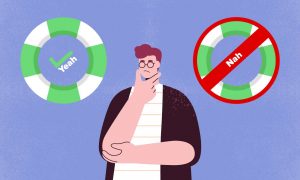Life insurance buyers traditionally have dependents or are married — in other words, they’re people approaching or older than 30. But there are reasons to get life insurance if you’re younger than that, and more 20-somethings may be doing so in the COVID-19 era.
A Money-Morning Consult survey of 2,200 Americans from the end of January shows Millennials and their successors, Gen-Zs, are more likely to dish out on coverage this year. And a study from LIMRA, a financial services research firm, shows that awareness about the need for life insurance protection has increased amongst Millennials by 71% since January of 2020.
However, while the pandemic has seemingly increased the interest in life insurance among the young, LIMRA data shows that only 52% of young adults own a life insurance policy. And one reason may be a tendency to overestimate the actual cost of coverage — by up to five times among Millennials, the bigger gap of any generation.
If you’re relatively young and thinking about buying life insurance, here are the main reasons to shop now:
You’ll lock in the lowest life-insurance premiums
The younger you purchase life insurance, the better it will be for your pocket. That’s because buying young entitles you to lower premiums for as long as you hold the policy.
With term life insurance, the most popular type, premiums remain the same from the time you purchase the policy unless you increase your coverage. As a result, buying in your 20s can actually allow you to pay less for every year of coverage.
For example, the average cost of a 30-year term $500,000 policy for a healthy female at age 27 is $225 annually, while for a healthy 27-year-old male, it’s $286. If you wait until you’re 37 to take out a policy, those rates increase to $238 a year if you’re a woman and $300 if you’re a man.
That means you could end up paying less in total by taking out a policy early. A 30-year policy on a man taken out at age 27 would run you to your mid-50s and cost you a total of $8,580. If, on the other hand, you took out a 20-year policy at 37, the total premiums would be $6,000. So you would be buying an additional decade of coverage for just $2,580 — for a modest but helpful reduction in the annual rate.
You won’t be shut out of coverage
Snagging a policy before you develop health conditions such as diabetes, high blood pressure, or high cholesterol can mean paying a significantly lower premium. And the younger you are, the less likely you are to develop those conditions.
There aren’t any specific health conditions that thirty-somethings are likely to develop, although that depends on the genetics and lifestyle of a person, according to LIMRA. Generally speaking, the younger you are, the healthier.
But suppose you have a family history of cancer or heart disease and lead a sedentary lifestyle. In that case, there’s a likelihood of developing health conditions such as diabetes, high blood pressure, or high cholesterol as you age.
For instance, if you buy a policy at 24 and develop health complications at 30, your premium rate won’t change. That’s exactly what happened to Mark Charnet, founder of American Prosperity Group.
Mark first purchased a life insurance policy when he was 24, looking to protect his wife and four children. Upon turning 30, he was diagnosed with diabetes which led to a quintuple bypass when he was 48, which led him to become uninsurable. Because Mark had purchased a policy before these health conditions developed, he could secure coverage with no premium increases.
However, Insurance expert Shelly Giuliano, senior project manager for the Government Employees’ Benefit Association, suggests shopping around for policies even if you already have preexisting conditions.
According to Giuliano, you’re more likely to find guaranteed-issue policies with no medical underwriting for smaller coverage amounts of around $50,000. “You can combine a couple of $50,000 policies and leave behind something pretty substantial if you passed away.” If you buy life insurance now, you will have protection when your partner, spouse, kids, or aging parents need it.
Protect your family from taking on your debt
Many Millennials are saddled with student loan debt. According to the Urban Institute, 70% of students finish college with some form of educational debt. Federal student loans are typically discharged if the borrower dies, but that’s not the case with private loans.
A life insurance policy can protect your parents or other cosigners from inheriting your debt if you die unexpectedly. And if you’re married or living with a partner with whom you have bought a home, purchasing a life insurance policy can protect them from defaulting on your mortgage by covering your lost income.
According to a recent study, 44% of Americans say their household would be significantly impacted within six months should a wage earner die. And the likelihood of younger, less financially established families being affected could be even higher.
Do I need life insurance in my 20s?
While planning for the future can be a smart financial move, some experts recommend putting off buying a life insurance policy until there is a need for coverage. In the meantime, you can focus on growing your savings.
Melbourne O’Banion, CEO of online life insurance company Bestow, suggests waiting to buy if you don’t have any dependents and have assets your family could use to cover final expenses. “Instead, you could put the money toward saving for a home or building your emergency savings.”
On the other hand, there are advantages to buying early. You may not have any dependents that rely on your income now, but that could change in a few years. The longer you wait, the more expensive it will get, as your health status may change without warning.
And according to LIMRA’s CEO David Levenson, the reality is that too many Americans are uninsured or underinsured. “For young people, taking the step now to ensure they are adequately protected can not only save them money long-term, but it can provide the foundation for a solid financial future.”
The post Reasons to Buy Life Insurance Young appeared first on Money
Original source: Money






